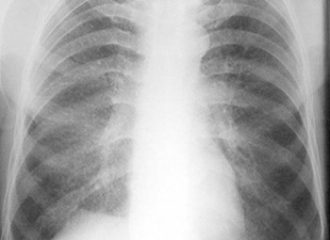Vesicant-Induced Lung Injury Research
 Sulfur mustard (SM) and nitrogen mustard are high priority chemical threats that cause debilitating damage to the respiratory system resulting in both acute and chronic effects. As this is the major cause of morbidity and mortality in exposed victims, it is essential to identify effective strategies to mitigate pulmonary toxicity caused by these vesicants. Our studies are focused on macrophages and inflammatory mediators as key to both acute lung injury and fibrosis induced by vesicants.
Sulfur mustard (SM) and nitrogen mustard are high priority chemical threats that cause debilitating damage to the respiratory system resulting in both acute and chronic effects. As this is the major cause of morbidity and mortality in exposed victims, it is essential to identify effective strategies to mitigate pulmonary toxicity caused by these vesicants. Our studies are focused on macrophages and inflammatory mediators as key to both acute lung injury and fibrosis induced by vesicants.
We discovered that following mustard exposure, a distinct subset of macrophages with proinflammatory/ cytotoxic activity (M1) and profibrotic (M2) activity sequentially appear in the lung. Our objective is to elucidate the contribution of these macrophage subsets to mustard-induced lung injury and fibrosis, with the overall goal of identifying new targets for therapeutic intervention. This mechanistic research is essential as macrophages are known to release numerous cytotoxic and profibrotic mediators; thus, targeting only one product or macrophage subset is unlikely to be effective in completely mitigating vesicant-induced lung injury. We hypothesize that M1 macrophages contribute to injury by generating cytotoxic oxidants and TNF?, which cause lung damage and promote lipid oxidation; oxidized lipids and TNFa upregulate macrophage scavenger receptors stimulating lipid uptake and the development of M2 macrophage foam cells, which play a key role in fibrogenesis.
To test this hypothesis plans are to (1) Elucidate the origin of M1 and M2 inflammatory macrophages responding to vesicant-induced lung injury and mechanisms mediating their accumulation in the lung; (2) Evaluate the role of oxidized lipids and M1 and M2 macrophages in foam cell formation and vesicant-induced fibrosis, and (3) Assess the contribution of TNF? to vesicant-induced acute lung injury and lung fibrosis.
An innovative combination of strategies will be used for our studies including lineage tracking, the generation of chimeric mice, adoptive transfer and monocyte/ macrophage depletion. We will also work closely with the Center’s Pharmaceutics and Medicinal Chemistry Support Core to refine a microparticle lung drug delivery system designed to specifically target profibotic M2 macrophages and with the Pharmacology and Drug Development Support Core to move one of our lead countermeasures for vesicant-induced lung injury into advanced drug development.
Successful completion of our proposed studies will result in a more precise understanding of the specific roles of macrophages in vesicant-induced toxicity, their origin, and mechanisms mediating their accumulation in the lung. This will have significant implications for the development of more efficacious strategies for mitigating mustard-induced lung injury and fibrosis.
Key Researchers:
Drs. Debra Laskin and Jeffrey Laskin
